Our
2004 travels to England’s West Country and Wiltshire
yielded a haul of intriguing books and pamphlets concerning
the mystical sites and personages of these areas.
Ordering
information for each of these publications is included
with the descriptions below. Some are available directly
from their publisher, others can be tracked down at particular
stores. A few are quite old, so finding a copy may require
some hunting.
If
you are ordering from a UK publisher or bookshop, it is
helpful to the bookseller if you send payment in British
pounds and include a self-addressed, stamped envelope
(weights for individual publications are provided for
the purpose of estimating postage costs).
To
see all the Wonderella recommendations, currently an annual
feature of this website, please follow the links here:
2002: The Best of the Independent Press
2003: Summer Reads
2004: Mystical England
2006: The Old Ways Are Best
Click
on the cover images for a closer look.

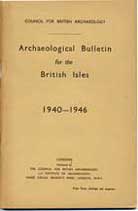
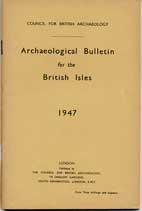
Archeological
Bulletin for the British Isles, 1940–1946 and 1947
editions: These two artifacts of an earlier time were
part of a modest binge I indulged in at a secondhand bookshop
in Totnes, Devon.
Published
by the Council for British Archaeology, the Bulletin was
the new incarnation of the Council’s annual index
of reports of archeological discoveries from prehistory
to 1600. The 96-page inaugural pamphlet is divided into
two sections. The first is a county-by-county index of
finds, each county’s section divided into eras like
“Paleolithinc and Mesolithic,” “Early Iron
Age,” “Viking,” and so forth. The second
section is a bibliography of 868 oral and printed source-works.
The
next year’s edition carries on the work of its predecessor,
listing another 95 pages of reports and sources from 1947.
It is assumed that the Council went on to publish the
Bulletin annually from here on.
The
Archeological Bulletin is printed A5 size, or 8.25 x 5.5
inches. Issues average 5 oz. Inquire about price and availability
from:
Pedlar’s
Pack Books
No.4, The Plains
Totnes, Devon TQ9 5DR
England

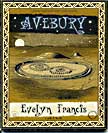
Avebury:
Despite the awful subhead “a genuine magikal places
ancient wizdom sorcebook,” [sic] this little booklet
provides a welcome and concise introduction to the structures
that comprise Britain’s oldest and grandest Neolithic
site.
In
the book, author Evelyn Francis presents over 40 historical
(and a few modern) illustrations of Avebury’s structures
and surrounding countryside, taken mainly from William
Stukeley’s “Abury, a Temple of the British Druids”
and Sir Richard Colt Hoare’s “Ancient Wiltshire.”
Each drawing is complemented with a brief lesson about
some geologic or mystic aspect of the site (e.g., “The
South Circle, What Was Left of It in Stukeley’s Day”
or the ley-line exploration “Hidden Currents: Evidence
of a Lost Science.”)
Avebury
measures 6 x 5 inches and weighs 3.4 ounces, and retails
for £4.99. It is often found in bookstores alongside
other Wooden Books titles in a handsome display stand.
If you’re unable to find it on your own, inquire
to:
Wooden
Books ,
Ltd
Walkmill, Cascob
Presteigne, Powys
Wales
The
bibliophile in me thinks it would be nice for this book
to be reissued casebound, or at least in a larger format
(to afford readers a closer look at the illustrations),
perhaps without all the mis-spellings on the cover.

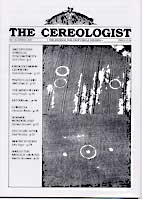
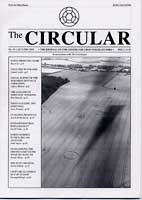
The
Cereologist No.36 and The Circular No.51: Where but
Southern England would one expect to find crop circle
pamphlets? It seems appropriate to review these two together,
as the Cereologist originated as an offshoot of the Circular
in 1990 and is now re-incoporating itself into its parent
publication.
Both
series explore classic and new theories behind crop circle
formation and significance, including the old saws of
alien (or angelic) involvement and bizarre weather patterns.
All is balanced with reminders to enthusiastic circlists
to remain grounded in earthly explanations whenever possible.
The
Cereologist and the Circular are printed A4 size, or 11.5
x 8.25 inches. The issues reviewed here were both 26 pages
in length and weighed 3 oz.
Further
information on the Cereologist can be found on the magazine's
website.
For remaining copies of the Cereologist, send your inquiries
to:
John
Sayer
17 Spindle Road
Norwich
Norfolk NR6 6JR
England
Issues
of the Circular are free to members of The
Centre for Crop Circle Studies. For a sample copy,
please send £4.20 (UK) or £7.00 (US and Canada)
to:
The
Centre for Crop Circle Studies
George Bishop
12 Tintagel Close, Beacon Heath
Exeter, EX4 9EH
England

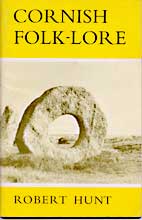
Cornish
Folk-Lore: This is Tor Mark Press’s 1969 reprint
of an 1871 collection of anecodotal legends of Cornwall
that originally appeared in a book called Popular Romances
of the West of England. A Cornwall publisher, Tor
Mark was, at least at the time, quite a prolific producer
of local interest pamphlets, judging by the 30 titles
advertised inside the front cover of “Cornish Folk-Lore.”
Without
much fanfare, the pamphlet begins its 48-page romp of
tales of Cornwall’s mythic past. In these stories,
which read like W.B. Yeats, shape-shifting spriggans swarm
to thwart treasure hunters, fully laden silver banquet
tables appear floating in the sea, and Christian saints
convert heathens by riding flying stones—to give
three typical examples. Magic!
Cornish
Folk-Lore is printed digest size, or 8.5 x 5.5 inches,
and weighs 4 oz. Inquire about price and availability
from:
Pedlar’s
Pack Books
No.4, The Plains
Totnes, Devon TQ9 5DR
England

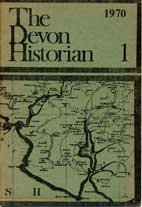
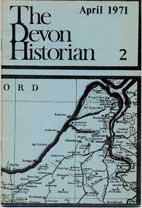
The
Devon Historian: As he explains in his opening essays
of this publication’s inaugural issue, editor Professor
W.G. Hoskins founded the Devon Historian to increase communication
between the county’s antiquarians and unite their
efforts toward a handful of projects. Hoskins is dismayed
by the lack of organization and cooperation among his
peers, and as such this charmingly produced local-interest
pamphlet series provides a wealth of ideas and resources
for budding and established scholars of Devon’s past.
Upcoming meetings are noted, regional libraries are enumerated,
and there is even a very straightforward essay titled
“Tasks for Devon Historians,” by Professor W.E.
Minchinton. Joyce Youings’s article “Devon’s
First Local Historians” profiles three early luminaries
of the county’s lore, giving the pamphlet a bit of
interesting material for readers who can’t follow
the Devon Historian’s task-list.
The
second number in the series continues along these lines
as the staff and readership of the Devon Historian get
down to business with articles on the county’s Domesday
records, the history of Devon trade unions, and the regional
pottery industry from the 17th through the 19th centuries.
Book reviews, a directory of Devon museums, and a useful
“Offers of Help” column fill some of this issue’s
other pages and show that all Devon’s historians
needed was a little encouragement and organization.
The
Devon Historian is printed A5 size, or 8 x 5.5 inches.
Nos.1 and 2 have 20 and 28 pp., respectively. Issues weigh
less than 2 oz. Inquire about price and availability from:
Pedlar’s
Pack Books
No.4, The Plains
Totnes, Devon TQ9 5DR
England

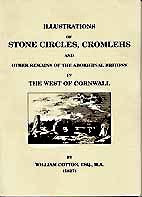
Illustrations
of Stone Circles, Cromlehs and Other Remains of the Aboriginal
Britons in the West of Cornwall: This impressive reprint
of William Cotton’s 1827 treatise on Cornwall stones
was issued by Ian McNeil Cooke, whose Men-an-Tol Studio
is near the stone formation of the same name. Cooke has
taken great care to preserve and present an “as new”
copy of Cotton’s rare and enthusiastic original work.
Cotton
spends the first two of this publication’s three
brief initial chapters recounting theories of the origins
of the earliest Britons and of the druidic priesthood
that oversaw matters of spiritual and judicial importance.
In the third chapter he posits the inspiration and purpose
of some of the stone formations found in Britain. Cotton
maintains that the structures are temples and sacrificial
sites similar to those found in early Biblical passages,
thus his theory that the idea of stone circles with central
altars was imported from the Middle East.
Most
of the remaining 40 pages of Cotton’s book are a
gazetteer of eleven circles, “cromlehs” (commonly
known as cromlechs or dolmens, these are standing stones
with another stone resting atop of them, most likely used
as burial chambers), and other formations to be found
in Cornwall, complete with accurate engravings that the
book’s modern publisher has reproduced beautifully.
The publication ends with an essay about some Land’s
End barrows excavated in 1826.
This
book is printed A4 size, or 11.75 x 8.5 inches, and has
76 pages. It weighs 10 oz. To order, contact Cooke directly
at:
Men-an-Tol
Studio
Bosullow
Newbridge
Penzance
Cornwall
TR20 8NR
England
Visit
the Men-an-Tol
Studio website to learn about other publications on
offer.

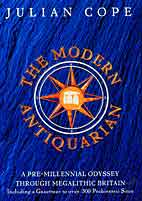
The
Modern Antiquarian—A Pre-Millenial Odyssey Through
Megalithic Britain: What can a Neolithic neophyte
say about The Modern Antiquarian that hasn't already been
said? Edited by psychedelic historian and rocker Julian
Cope, this hefty, gorgeously produced volume is an essential
companion on any trip to see the stones.
Julian
takes a wide-eyed view of Britain's pre-Roman history,
devoting the first 150 pages of the 438-page volume to
his Goddess-worship theories and hypothesizing their effects
on the islands' culture and language. At times his etymological
riffs are a bit far-fetched, but open-minded readers will
enjoy the expansive effect on their imaginations.
The
rest of the book is a gazetteer of more than 300 prehistoric
sites conveniently arranged by region. Maps, color photographs,
history, and Julian's own first-person commentary are
beautifully presented for each site.
The
highly interactive website Head
Heritage provides an online complement to the book
and contains recent news items, monthly essays, a forum,
photo albums, and web logs.
Admittedly,
Jeff and I had a copy of the Modern Antiquarian well before
we began our journey, and we always kept it within reach
during our travels throughout mystical England in 2004,
using it until the binding came apart. We found all we
were looking for and more using just it, along with the
occasional OS map for particularly well-hidden sites.
The
Modern Antiquarian is printed roughly A4 size at 11.25
x 7.8 inches. It weighs just over 4 lbs., but gets lighter
with each site you visit.
To
obtain a copy, order via the Head
Heritage website, ask for it by name at your local
bookstore, or send $57.31 (plus shipping) to:
Thorsons
77–85 Fulham Palace Road
Hammersmith, London W6 8JB
England

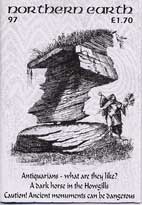
Northern
Earth No.97: This terrific 32-page pamphlet offers
a mother lode of earth mysteries–related news items
from around Britain (this issue didn’t mention anything
from Ireland, but past numbers have). The enthusiastic—and
sometimes humorous—items are mainly in briefs form,
but some well-written long articles (including one 19th
century reprint) are included.
If
the editors of Northern Earth have kept to their quarterly
schedule, then the 100th issue of this fine pamphlet should
be available now. Quite an achievement, that.
Northern
Earth is printed A5 size, or 8.75 x 5.5 inches. This issue
has 32 pages and weighs less than 2 oz. Order yours from:
Northern
Earth
10 Jubilee Street
Mytholmroyd
Hebden
Bridge
West Yorkshire
HX7 5NP
England
More
information (and a complete index of articles) can be
found at the Northern
Earth website.

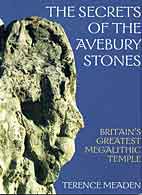
The
Secrets of the Avebury Stones—Britain’s Greatest
Megalithic Temple: Mystical antiquarian Terence Meaden
explores the history of England’s largest neolithic
site. While Meaden incorporates the usual information
about the changing face of Avebury over centuries of reverence
and desecration, what he’s truly interested in are
Avebury’s changing faces.
Meaden’s
theory states that most of the stones in Avebury’s
central ring—and many in the outlying structures—are
carved (by natural or limited manual means) to show sombre
visages at different times during the year. Explorations
of the stones’ use in fertility rites are also included.
All this is backed up with a wealth of black-and-white
and color photographs in this highly recommended book.
The
Secrets of Avebury measures 10 x 7.25 inches and weighs
14.7 ounces. For
ordering information, please contact:
Frog,
Ltd
c/o North Atlantic Books
P.O. Box 12327
Berkeley, Calif. 94712

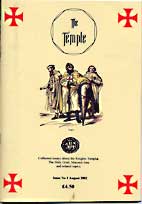
The
Temple No.1: Here we have something even more intriguing
than a crop circle pamphlet—a Templar pamphlet! This
gem was found in a bookshop in Glastonbury, home of Temple
editors Oddvar Olsen and Yuri Leitch. (Leitch left The Temple after the second issue to pursue other projects, including his stunning visual art.)
This
inaugural issue features a brief history of the Knights
Templar, followed by essays on topics related to the Knights,
namely the Holy Grail, Avalon, and “Lady Wisdom” (referring to the feminine side of the godhead).
The
Temple is printed A5 size, or 8.25 x 5.5 inches. Several
issues have been published since the original printing
of No.1 in August 2002.
In October 2005, Temple editor Oddvar Olsen informed Wonderella of the series’ new website. He also mentioned that a compilation of the first six issues of The Temple is in the works and that mail for the series should come to the new address listed here:
The
Temple
25 Welsh Court
Charter Way
Wells
Somerset
BA5 2GD
United Kingdom